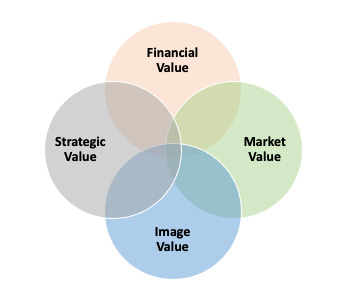By Gary Shawhan, Phil Phillips Contributing Editors
The CHEMARK Consulting Group
In business, the word “value” is used to describe a wide variety of circumstances. Websters lists several definitions for the word “value”. In the context of this article, the definition that best fits its intent is as follows: “ to rate or scale in usefulness, importance, or general worth : EVALUATE”.
The role of “Value” in business management and strategic planning is represented by the four sectors shown in Figure 1.

Figure 1: Sectors of “Value” Impacting Management and Strategic Planning
In the context of this article, these value sectors can be generally characterized as follows:
Table 1: The “Value” Sectors
- Financial Value
Financial data, metrics, and statistical analysis done at the corporate or company level - Strategic Value
Strategic planning, management vision and longer-term business direction - Market Value
On-going information gathering and analysis at the product/technology and market segment level - Image Value
Market segment driven tactics and activities that enhance a company’s position in the markets they serve
In general, all companies, regardless of the size and breadth of their business, must deal with each of these elements in the process of managing their business. The importance or level of effort required significantly varies organization-to-organization.
Financial Value
Financial performance is an essential element in identifying and quantifying value at all levels of an organizational. This activity involves an assessment and analysis of past and current financial performance. Just as important it provides management a basis for setting future financial and business goals for the business.
Financial value determination is a quantitative activity. It involves gathering extensive detail on the company’s present business situation. It also includes analysis of the data in relation to past performance as well as adding perspective to future business goals and objectives. In addition, it is a necessary component of the decision-making process when some course corrections in strategy may be required.
Organizational metrics have traditionally relied on financial data to analyze the overall health of the company. In this vein, Value Based Management (VBM) is a model that was developed by McKinsey and Company and adopted by many companies during 1990’s.
VBM defines value for a company as being the discounted cash flows derived from investments made in the business. In this regard, value is created when the return on investment exceeds the cost of capital. The key point here is that when employing a discounted cash flow benchmark, it necessitates consideration of the longer-term values that can be realized from a given investment.
For large public corporations, the best investments in Value Base Management are those that maximize shareholder’s equity. When using this as the primary metric for strategic decision making, the consequence is often that management choices favor shorter-term results that minimize risk.
Results from taking this approach are two-fold. First, companies are increasingly focused on growing share within the markets where they are currently a strong or leading participant with the intent being to maximize profitability in the short-term.
Second, the importance of longer-term growth opportunities outside of this core business focus is often de-emphasized. The consequence is not being effectively positioned to anticipate and respond to changes in the marketplace and associated business dynamics.
The traditional metrics associated with Value Based Management, in addition to discounted cash flows, include the return that is provided to shareholders, return-on invested capital as a percent of total company cash flow, the ratio of net operating profit to invested capital and others.
Today, the advancement and utilization of analytics allows for a significant expansion of the sources for gathering data and analyzing information about business operations. This information can be accessed to support decision making. Analytics can be extremely helpful for companies that supply products into markets where there is a direct connection with consumers.
In this regard, analytics can add dimension and perspective to the strategic process by providing more extensive bridge between business operational data and straight financial information. By looking more thoroughly at trend lines and the meanings behind the financial data better, longer-term decision making can be improved
Strategic Value
Strategic value can be described as planning and implementing the longer-term direction for the company. In one sense, it is the vision and leadership portion of the four sectors of “value”. Companies that sustain growth and retain and successfully adapt their position in the market they serve are ones that execute and excel in their efforts to address strategic value issues.
Strategic value is both a qualitative and a quantitative activity. Depending on the composition of the company’s business and the different elements that comprise it, the balance between these two activity types can vary significantly. Among the many determinants of this balance are business fragmentation, channel-to-market, regulatory/compliance issues, geographical complexities, … and many others.
Strategic value determination needs to garner input throughout the organization to be effective. Strategic value is also fluid and changeable. Senior leadership, middle management, the sales organization, and operations people all face the challenges of being competitive and reacting to customer needs.
Within the broader framework of an organization, there exists a wealth-of-knowledge that represents a sense of the current market and customer needs. This collective intelligence contains important insight into longer-range opportunities where, through investment, the company can achieve sustainable growth. This shared knowledge also provides valuable input on threats and unmet needs that help keep a company competitive.
The creative energy of the company, regardless of its size, is a key to sustainable growth. Larger corporations have the responsibility to deliver a steady pattern of positive financial results. In this effort, it is easy to lose sight of the broader view of the business and issues of strategic value.
Too often, strategic value comes into conflict with financial value. Financial value, as a sole or primary focus, can become more of a top-down driven approach. The difference between leadership and a top-down directed management style in addressing strategic value is significant. Having organizational involvement and buy-in as part of the strategic process is a reflection on leadership style.
Market Value
Market value determination and monitoring is fundamental to most every business strategy, regardless of how large or small the company may be. Assessment of market value is a mixture of quantitative analysis and qualitative elements. The importance of understanding and monitoring market value is an essential component to maintaining the health of a business.
Market value is the on-going process of identifying and characterizing the elements of value contained in the individual market that comprise the important parts of the business. This not only includes understanding the current market situation but also looking forward to changes and trends in each key market area for each separate business area. Market value intelligence is a basic need for most all companies. It is of critical importance to company’s serving markets that are growing, in transitional or embryonic in their nature.
Table 2 highlights examples of both quantitative and qualitative elements of market value which are often monitored by a company.
Table 2: Element of Market Value
Quantitative
- Market Size
- Market Share
- Competitive Landscape
- Competitor Share
- Benchmarking
- Manufacturer/End-user Assessment
- Applicator/Customer or OEM/Tier Supplier Profiling
- Needs/Unmet Needs
- Supply Chain
- Needs/Unmet Needs
Qualitative
- Technology Trends
- Market Shifts
- Major Shifts in Finished Product Design & Manufacturing
- Changes in Substrate Materials
- Disruptive Technologies
- Impactful External\Issues
- Regulatory, Environmental Requirements, Trends
- Geographical Shifts
Companies that can sustain a strong market position and have success in transitioning key elements of their business are ones that adapt their business strategies to changing market conditions.
Image Value
The importance of image (relative to other values) shifts considerably depending on the industries and markets which constitute a company’s business portfolio. For coatings, there are two separate categories where image value is a key element of a successful business strategy.
First, there are those industries/markets where the coating manufacturer comes into direct contact with the consumer. Second, there are those markets that involve a high level of performance and carry with them elements of liability that elevate the need for quality, consistency, and support from the supplier.
For the major coating manufacturers, their market reach is broad and as such both qualitative and quantitative scenarios apply but vary in importance between different portions of their business. For medium to smaller-size coating manufacturers, the role of image value and its importance is normally narrower in scope.
For those companies supplying to the architectural paint market, image value is a clearly a necessary consideration. Brand image and reputation become an essential part of the company’s business strategy. Conventional advertising, exposure through social media and the internet are strategically essential to building image value for the company at the consumer level.
Differentiators, directed at strengthening image value through brand recognition and consumer preference, include things such color and seasonal trends, sustainability considerations or specialty product features such as mar resistance. In consumer driven markets local sourcing is very important. For example, DIY is a key component of doing business the architectural paint market.
In this regard, company-owned stores, retail hardware stories, big box home centers or independent, local paint store represent the alternative channels-to-market through which image value must be built and maintained.
Alternatively, for performance and/or specification driven markets, the important of technical support and customer service represent key elements of a company’s image value in the marketplace. Supplier reputation for quality, and consistency along with a track record for standing behind their coatings is especially important to customers who provide a warrantee on the products they have coated. OEM’s that warrantee their equipment exposes themselves to liability which puts a premium on supplier confidence and reliability.
In fast growing, emerging or transitional markets such as medical the images of innovation and excellence in quality is necessary. The same can be said for markets like consumer electronics. In both cases the company image is an essential element of value in determining market success.
Linking individual consumers and their buying habits to brand identity and preference becomes a necessary part of doing business. Today a key tool for accomplishing this objective and building brand image is analytics. Analytics brings a unique value in those markets that require a directed choice from individual consumers.
In next month’s article the relationship between these four values and their relevance to market positioning as defined by Porter will be discussed.
